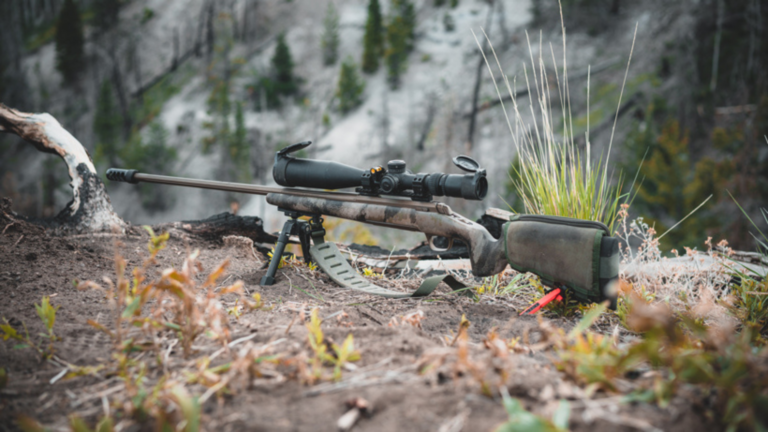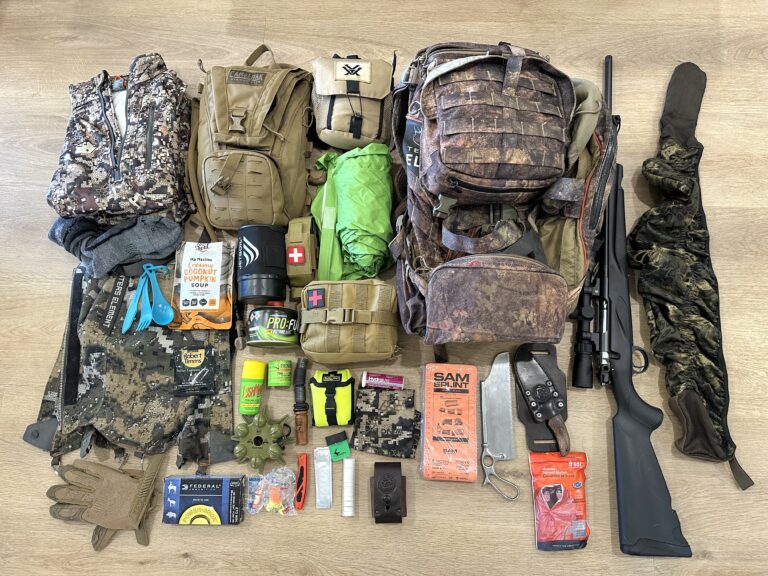Previously, I discussed the proposition of hunters and law-abiding firearm owners assisting our conventional armed forces in the event of a foreign invasion. Understandably, this concept was met with concerns and mixed opinions. This article aims to clarify the hypothetical roles and training that a volunteer could undertake to strengthen our national security.
Core Principles for Civilian Volunteer Training
-
Simplicity and Scalability
-
Volunteers would enter service with a varying level of experience. Therefore, all training must be modular and easy to understand.
-
Focus must be placed on skills that provide immediate defensive value. For example; marksmanship, advanced first aid training (i.e. “Stop the bleed“), and the use of modern communications technology.
-
-
Defensive and Asymmetric Mindset
-
Volunteers would act as a force multiplier by assisting conventional troops with security, basic reconnaissance, and in other supporting roles, rather than in a direct offensive capacity. Their involvement could range from relatively low-risk activities, such as transport and logistics, or in a higher-risk setting by observing and reporting enemy activity in their local area.
In simple terms, I am NOT suggesting that we attempt to transform a bunch of rag-tag overweight Call of Duty players into the A-Team. The intent is to augment conventional forces and establish an additional layer of protection for our local communities.
-
-
Safety First
-
Volunteers must understand the risks associated with their involvement and avoid unnecessary exposure.
-
Weapons training should be progressive, with strong leadership and supervision.
-
-
Concessions for service
-
- Concessions must be made to volunteers to account for their service. This may include free training for skills that can be used in civilian life, such as heavy vehicle or coxswain licences. Active members should be exempt from the costs of firearms licencing and the fees associated with maintaining relevant qualifications.
Roles
Reconnaissance and communications – As a minimum, this role would require volunteers to become proficient in basic observation and reporting techniques, and be capable of administering first aid. Not withstanding an invasion, this capability could be utilised to improve community safety by allowing accurate and timely reporting of crime and antisocial activity to local police services.
The ideal applicant would be capable of delivering clear and consistent communication and have a strong foundation of mathematics, pattern recognition, and is be proficient in the use of basic technology. Age and fitness levels would not apply to this role.
Construction and labour – Used in the repair and maintenance of roads, fortifications, and other important infrastructure.
The ideal applicant would have trade qualifications or plant operator tickets, and have a moderate level of physical fitness.
Transport and logistics – Qualified and experienced heavy vehicle drivers would be able to assist in the transport of supplies, while more technical volunteers could assist in supply chain management and logistics planning. Other roles and responsibilities could be undertaken as deemed necessary – i.e. warehousing.
The ideal applicant would already hold the relevant skills, including a heavy vehicle licence and a forklift ticket, and must be capable of maintaining a moderate level of physical fitness. Experience in supply chain, planning, or project management would be suited to a role in logistics.
Sentry | Light Infantry – This is where the topic of voluntary national defence gets controversial. Putting aside the titles that I’ve applied to this proposed role, there is a very real need for Australian’s to develop the underlying skills of this role, including: marksmanship, self-defence, and First Responder Tactical Trauma (FRTT). This extends far beyond national security concerns, and is centred around the protection of the family unit. Specifically, in respect to the proposed implementation of castle doctrine (castle law). Unfortunately, these laws are unlikely to change without a strong catalyst that clearly demonstrates that we are not only a lesser threat than criminals, we are in fact a viable solution to our nation’s crime problem. I believe the Citizen’s Military Force (CMF), particularly this role, could serve as that catalyst.
Anyway, back on subject of role responsibilities – suitably qualified individuals could be used to fulfil a number of important duties, including; security for important assets, or in a resistance capacity – similar to many French citizens in WW2, and more recently, the Ukrainian population during their war with Russia (Russo-Ukrainian War, circa 2014 – current). The one advantage we have over these nations is that we’re currently not engaged in a war. This gives us the opportunity to develop and implement this concept ahead of time, which theoretically, should translate to better trained volunteers and hopefully, a lower number of battlefield causalities.
Unfortunately, this opportunity is closing fast. If we do not act quickly, we risk being caught off-guard and under prepared. That’s why your proactive support for this concept is vitally important.
Onboarding process
A thorough background check should be performed in accordance with standard firearms licencing requirements. Once approved, a follow up interview could be conducted by a recruitment agency (i.e. ADF Recruiting, or equivalent). This interview would ensure the applicant is able to meet the physical, mental, and aptitude requirements that apply to their chosen role.
Minimum standard of fitness
Physical fitness standards should fall in-line with the requirements of each role. Understandability, due to infrequent nature of training, and the limited support these roles would provide, this standard would be set lower than the ADF recruitment levels.
For the sake of applying an arbitrary figure, I’ll suggest that all applicants – pending role, should be capable of the following at the time of onboarding:
- 10 push ups.
- 20 sit ups (in 1 minute).
- 5.0 beep test.
These figures match the entry standard of the Royal Australian Air Force, with exception of the beep test number. This has been lowered from 6.5 to 5.
How could fitness be improved or maintained?
In my opinion, volunteers should be provided with subsidised gym memberships. This will encourage them to improve their physical fitness and also has the advantage of lessening the burden on our healthcare system.
Training modules
All roles – minimum standard of training
- Basic first aid.
- Radio and communications.
- Firearms safety and basic marksmanship.
- Familiarisation with enemy weapons and equipment.
- Mental resilience.
Observation and reporting
- Basic reconnaissance – i.e. observation and reporting.
- Map and navigation.
Transport and logistics
- Appropriate licences and training – i.e., Heavy vehicle, Fork lift, Coxswain, etc.
- Pre-requisite skills, or on the job training for supply chain management and logistics co-ordination.
Sentry | Light Infantry
- Basic bushcraft and survival skills
- Map and navigation
- Training in the use of light vehicle – i.e., 4wds, motorcycles, watercraft.
- Intermediate firearms and marksmanship training.
- Small unit and defensive tactics.
- First Responder Tactical Trauma (First Aid) – “Focuses on immediate trauma care in high-risk environments, teaching TECC principles, threat identification, haemorrhage control, and casualty management under pressure.”
- Basic reconnaissance – i.e. observation and reporting.
How would training be undertaken?
The basic concepts for most of these skills can be taught online via a learning management system (LMS). However, competency in each skill MUST be refined and tested in person using realistic training scenarios.
Face-to-face training could be split between hunting and target shooting clubs, and the ADF. For instance:
- Basic firearms safety and bushcraft skills could be taught by accredited trainers from hunting and target shooting clubs. This training could be subsided by the Government.
- All military-specific training could be taught by the ADF. This would ensure quality training and reduce overhead expenditure.
Length of service
Due to the voluntary nature of this role, there would be no minimum length of service. However, If an applicant quits within 12-months of undertaking certain training modules – i.e. a heavy vehicle licence, that person would be required to pay back the cost of the training in full. The same applies if this person takes advantage of specific benefits that relate to their roles, like a subsidised gym membership.
Risk Vs Reward
Overall cost vs training outcomes
The cost of his initiative would be significantly lower than expanding our conventional forces. The trade-off is quantity over quality. The overall proficiency of volunteers would be lower, in exchange for a higher overall number of participants. On face value this may seem like a negative. However, its the same approach that many other countries are taking to deter a foreign aggressor, with Taiwan and Ukraine being notable examples. The difference between the two is how each went about implementing this strategy –
- Ukraine failed to train their citizens and heavily restricted firearms ownership before their war. As a result, they suffered significant casualties at the start of the war and many of their citizens fled the country.
- Taiwan is being proactive and preparing their civilian population before a conflict occurs. While they are yet to be tested, its fair to suggest they will be better prepared with equipment and skills, when compared with Ukraine.
Based upon figures released in 2022, Taiwan has a staggering 420,000 volunteers registered as members of their of civil defence program. With a population smaller than Australia (Approx. 23.4 million) I see no reason why we can achieve a similar sized number of volunteers to defend our country.
Military training vs risk to public safety
It’s often said that teaching the average Australian military tactics would put the general public at risk of greater harm. This is often followed by an assertion that one of two hypothetical scenarios would occur:
- An extremist would use this training to orchestrate a mass casualty event, or;
- A fatality would occur due to the gross negligence or stupidity of a volunteer.
I wholehearted disagree with both scenarios, and here’s why:
- Participation would require an applicant to undergo a background check to the same standard as a firearms licence. If a person is capable of passing this background check, there’s nothing stopping them from obtaining a firearm and using it to cause harm to another person, even without military-specific training.
Remember – Our nation’s largest mass casualty event involving a firearm was said to be committed by an untrained individual with a IQ of 66. Mind you, this was an individual who did not hold a firearms licence, which from my understanding, was required to posses the type of firearm that was used in this horrific event.
- Throughout recent times it has been proven that a similar level of devastation can be committed with uncontrolled items, such as knives, motor vehicles, and other household items. This clearly demonstrates what we already know to be true – A lack of skills or access to firearms does not prevent crime.
- A mandatory reporting safeguard could be built into this organisation which mirrors the current requirements of our hunting and target shooting clubs. In essence, any person who is deemed to be reckless or unsafe could be provided with further training and support to address any areas of concern. Repeat offenders could be removed from the organisation, or have their firearms removed from their possession.
- Parallel’s are often drawn between the number of firearms “on the street“ and the level of gun violence in our community. While this comparison may be accurate for illegal or unregistered firearms, there has never been a proven correlation between the number of registered firearms in the public’s hands and the number of crimes committed with firearms. This is why the Australian Bureau of Statistics (ABS) and the Australian Institute of Criminology (AIC), along with Politicians and state police refuse to support firearms statistics being recorded as either involving registered or non-registered firearms.
- The concept above also applies to training. Exposure to police or military training does not automatically make an ex-servicemen or retired police officer a threat to the community. Neither would the training proposed under this CMF concept.
Final Thoughts
If you’ve read this far and you’re still on the fence about my proposal, I want you to consider the following question – Is there a precedent for volunteers to undertake similar roles in Australia?
The answer is yes.
Transport, logistics, and supply chain management are routinely performed by volunteers of not for profit organisations. Communications, intelligence gathering, incident management, and front line support is provided by volunteers as part of the Rural Fire Service (RFS), the State Emergency Service (SES), and many other organisations.
If we trust the average Australian to support us in a moment of natural crisis –
- To preserve our homes from significant storm damage.
- To rescue our children, ourselves, and the elderly during floods or fires,
- To put their lives at risk to protect our community.
Then why are we so resistant to having a volunteer support us in a national defence capacity?
There is no logical reason.
As it stands, we already have volunteers supporting national defence by way of the ADF reserves. My approach simply expands the size of our force along with our overall defence capability.
We often mourn the loss of our generational values. The most notable being Mateship and national pride. Re-establishing this version of the CMF, or something similar, is our chance to recover those lost values by giving the average Australian the opportunity to serve a cause greater than themselves. To support our nation!
Full time employment or multiple weeks of ‘block’ training isn’t a viable option for everyone. Just as participating in this concept won’t be for everyone. But that’s not a good enough excuse to prevent, or discourage it.









